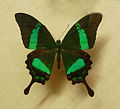|
Papilio palinurus
Papilio palinurus, the emerald swallowtail, emerald peacock, or green-banded peacock, is a butterfly of the genus Papilio of the family Papilionidae. It is native to Southeast Asia, but is regularly kept in butterfly houses around the world. SubspeciesThere are several subspecies (from Burma, Borneo, Indonesia, Nias and the Philippines).
EtymologyThe genus name Papilio comes from the Latin word papilio meaning butterfly. The species name palinurus derives from Palinurus, the name of the pilot of Aeneas's boat in Virgil's Aeneid. DescriptionPapilio palinurus has a wingspan reaching about 8–10 centimetres (3.1–3.9 in). The dorsal sides of the wings are covered by a powder of green scales and the background vary from dark greenish to black, with broad bright emerald green metallic bands. The undersides are black with orange, white and blue spots along the edges of hindwings, that show extended tails at the end. The flight of these butterflies is swift and quite fast. Caterpillars feed on plants of genus Euodia belonging to the Rutaceae, commonly known as the rue or citrus family. Green by structural coloration The iridescent green sheen of the bands of this butterfly is not produced by pigments, but is structural coloration produced by the microstructure of the wing scales. They refract the light and give rise to blue and yellow visible reflections, producing the perception of green color when additively mixed.[2][3][4] DistributionThis species can be found primarily in Southeast Asia, particularly in Burma – Peninsular Malaysia, Sumatra, Borneo, Indonesia (Simeulue, Island of Nias), Philippines (Basilan, Palawan, Balabac, Cuyo, Busuanga, and Dumaran). HabitatPapilio palinurus lives in Asian primary forests. Gallery
References
Further reading
External linksWikispecies has information related to Papilio palinurus. |
||||||||||||||||||||||||||




